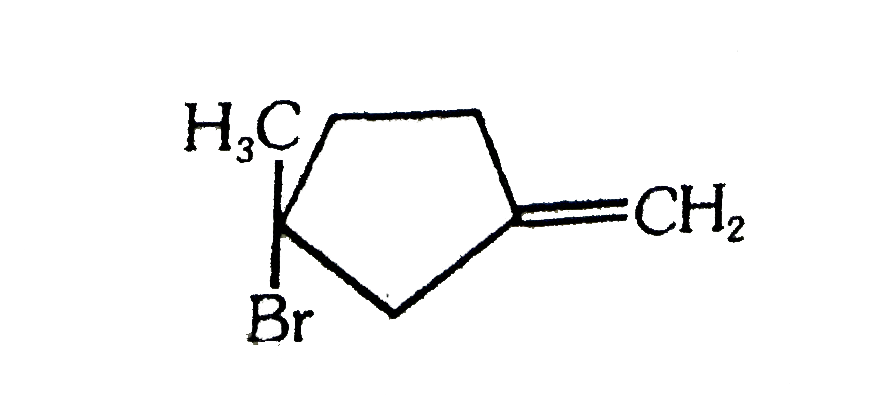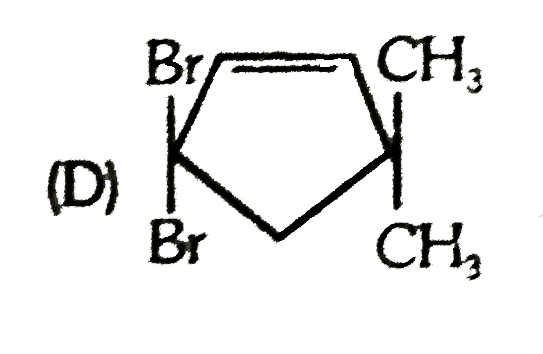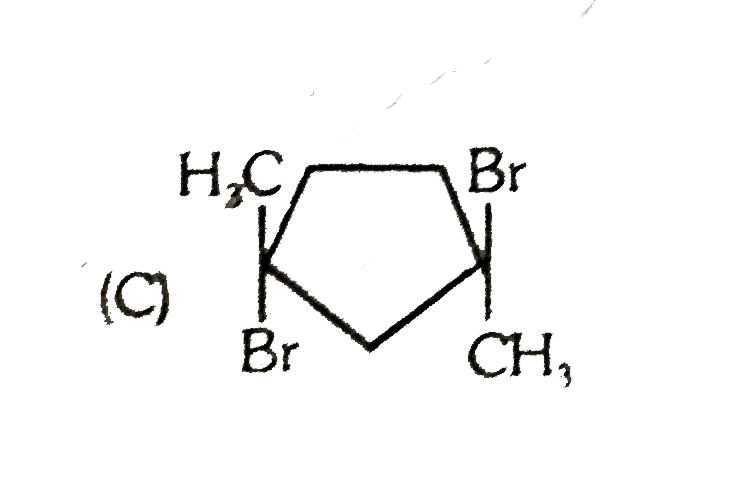An optically active compound A (assume dextrorotatory) has the molecular formula C7H11Br. A reacts with hydrogen bromide, in the absence of peroxides to yield isomeric products, B and C, with the molecular formula C7H12Br2. Compound B is optically active, C is not. Treating B with 1 mol of potassium butoxide yields (+)−A. Treating C with 1 mol of potassium tert-butoxide yields (±)−A. Treating A with potassium tert-butoxide yields D(C7H10). Subjecting 1 mol of D to ozonolysis followed by treatement with zinc and acetic acid yields 2 moles of formaldehyde and 1 mole of 1,3-cyclopentanedione.

The optically active compound 'A' is




The correct Answer is:B
Step by step video, text & image solution for An optically active compound A (assume dextrorotatory) has the molecular formula C_(7)H_(11)Br. A reacts with hydrogen bromide, in the absence of peroxides to yield isomeric products, B and C, with the molecular formula C_(7)H_(12)Br_(2). Compound B is optically active, C is not. Treating B with 1 mol of potassium butoxide yields (+)-A. Treating C with 1 mol of potassium tert-butoxide yields (+-)-A. Treating A with potassium tert-butoxide yields D(C_(7)H_(10)). Subjecting 1 mol of D to ozonolysis followed by treatement with zinc and acetic acid yields 2 moles of formaldehyde and 1 mole of 1,3-cyclopentanedione. The optically active compound 'A' is by Chemistry experts to help you in doubts & scoring excellent marks in Class 12 exams.
Updated on:21/07/2023Topper's Solved these Questions
- ALKYL AND ARYL HALIDEBook:ALLENChapter:ALKYL AND ARYL HALIDEExercise:EXERCISE-04 [A]
Explore 1 Video
- ALKYL AND ARYL HALIDEBook:ALLENChapter:ALKYL AND ARYL HALIDEExercise:EXERCISE-04 [B]
Explore 1 Video
- ALKYL AND ARYL HALIDEBook:ALLENChapter:ALKYL AND ARYL HALIDEExercise:EXERCISE-03
Explore 1 Video
- ALKENE, ALKANE & ALKYNE Book:ALLENChapter:ALKENE, ALKANE & ALKYNE Exercise:EXCERSISE-3
Explore 28 Videos
- Atomic StructureBook:ALLENChapter:Atomic StructureExercise:All Questions
Explore 59 Videos
Similar Questions
Knowledge Check
An optically active compound A (assume dextrorotatory) has the molecular formula C7H11Br. A reacts with hydrogen bromide, in the absence of peroxides to yield isomeric products, B and C, with the molecular formula C7H12Br2. Compound B is optically active, C is not. Treating B with 1 mol of potassium butoxide yields (+)−A. Treating C with 1 mol of potassium tert-butoxide yields (±)−A. Treating A with potassium tert-butoxide yields D(C7H10). Subjecting 1 mol of D to ozonolysis followed by treatement with zinc and acetic acid yields 2 moles of formaldehyde and 1 mole of 1,3-cyclopentanedione.

The compound 'B' is:A B
B C
C D
D
An optically active compound A with molecular formula C8H14 undergoes catalytic hydrogenation togive meso compound, the structure of (A) is:
A B
B C
C D
D
A compound with molecular formula C7H16 shows optical isomerism, the compound will be
A2,3−dimethy1pentaneB2,2−dimethy1phentaneC2−methy1heptaneDnone of these
An optically active compound having molecular formula C7H15Br reacts with aqueous KOH to give a racemic mixture of products. Write the mechanism involved for this reaction.
View SolutionAn optically active compound having molecular formula C7H15Br reacts with aqueous KOH to give a racemic mixture of products write the mechanism involved in the reaction.
View SolutionDraw all structurally isomeric cyclic bromides with molecular formula C4H7Br.
View SolutionWrite the structure of tert-alkyl halide having molecular formula C5H11Br.
View SolutionA compound with molecular formula C7H16 shows optical isomerism, the compound will be:
View Solution

